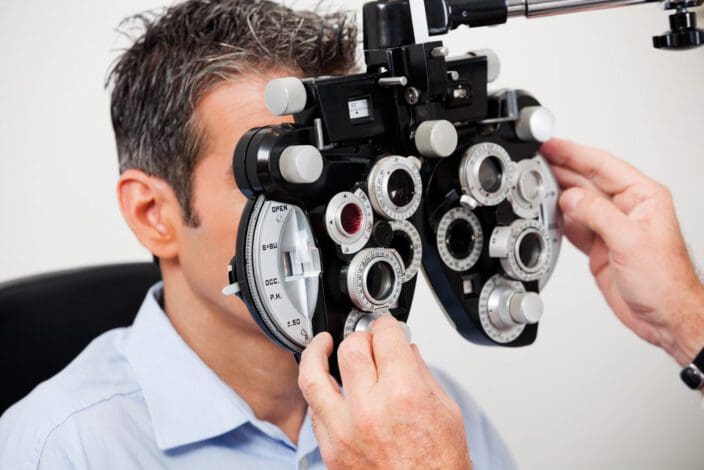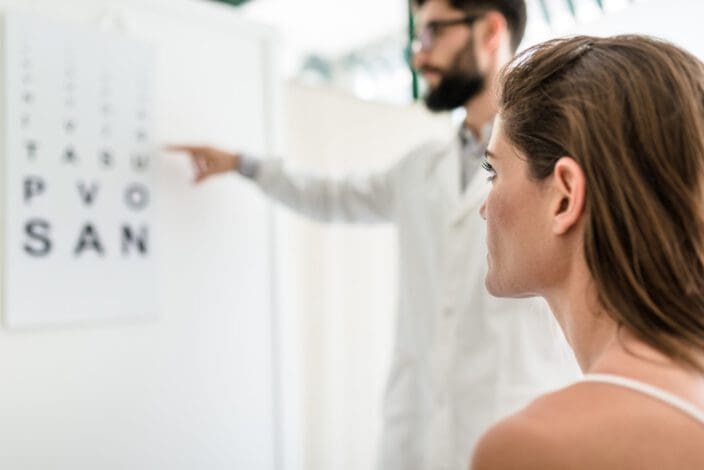What Is 20/15 Vision & How Can Someone Get It?
Home / How to Improve Your Eyesight Naturally /
Last Updated:
Strong and healthy vision makes almost every aspect of life easier. Most people are familiar with 20/20 vision, but 20/15 vision is even better.
Table of Contents
If you have 20/15 vision, you can see things at 20 feet that people with normal 20/20 vision can see at 15 feet. This means you have vision that is better than 20/20, but not quite as good as 20/10.
Eye doctors can perform various tests to determine vision acuity.
Some people naturally have 20/15 vision. If your vision is not normal, there are things you can do to improve it.
Corrective lenses and LASIK are both treatment options. With LASIK, the goal is improved vision, not necessarily 20/15 vision.
What Is 20/15 Vision?

Visual acuity describes how sharp a person’s vision is. To measure acuity, a person looks at numbers or letters according to a fixed standard at a given distance.
Normal vision is considered 20/20 vision. This means you can see things at 20 feet that a person with normal vision can see at 20 feet. If you have 20/15 vision, you can see things at 20 feet that a person with normal vision can see at 15 feet. This means that 20/15 vision has greater acuity than 20/20 vision.
There are neurological and physical factors involved in determining visual acuity. These include:
- Nerve sensitivity in the brain’s vision centers and retina.
- How accurately the eye’s lens and cornea focus light onto the retina.
How well the brain interprets the information the eyes send to it.
Is 20/15 Vision Good?
Is 20/15 vision good? Yes, 20/15 vision means that you can see things at 20 feet that people with normal 20/20 vision can see at 15 feet. This level of visual acuity is considered better than 20/20, indicating a higher level of sharpness and clarity. However, it’s essential to understand that visual acuity alone doesn’t determine overall eye health or the absence of other visual issues.
How Is Vision Measured?
Visual acuity is measured using the Snellen chart. Traditionally, this chart has a white background with black numbers or letters in varying sizes. While not as common, some doctors use video monitors that display images or letters.
The Snellen test is performed in the following way:
You deserve clear vision. We can help.
With 135+ locations and over 2.5 million procedures performed, our board-certified eye surgeons deliver results you can trust.
Your journey to better vision starts here.
- Cover one eye with your hand or a small paddle.
- Stand 20 feet away from the chart.
- The doctor will ask you to read a specific line and make note of the accuracy.
- More than one line may be read.
- The test is repeated on the other eye.
The doctor will use the visual acuity measurement on the smallest line you can read accurately to provide a vision assessment. For example, if the smallest line you can read accurately is the 20/15 line, you have 20/15 vision.
The chart’s top number describes how far you stood from the chart. With 20/15 vision, you were 20 feet away.
Everyone should take a Snellen test according to their doctor’s recommendation. On average, kids should have their first test when they are old enough to work with the doctor to cover an eye and use the chart. How often they need to have the tests will depend on their results.
Once people reach age 60 or 70, it is normal to experience a slight decrease in visual acuity.
Many people start to notice changes around middle age. These changes are normally with near vision more than acuity. Because of this, it is recommended to get a baseline eye examination around 40 years old.
As people get older, the lenses in the eyes start to lose their flexibility. This can make it more difficult to switch focus from far away objects to those that are near. Eye doctors refer to this as presbyopia. Bifocals or reading glasses might be needed to correct this issue.

How Can You Achieve 20/15 Vision?
It is possible to have 20/15 vision naturally. People can also achieve this level of visual acuity through corrective surgery, such as LASIK. However, undergoing corrective surgery does not guarantee that you will achieve 20/15 vision.
While advanced LASIK technology can often achieve 20/15 vision, the goal is simply to improve vision as much as possible.
How Age Affects It

Whether you have 20/15 vision due to surgery or naturally, it can decrease with age. With age, the following vision changes are normal:
- It becomes more difficult to focus on close objects.
- You need more light to see well.
- It is harder to tell the difference between colors, such as black and dark blue.
You deserve clear vision. We can help.
With 135+ locations and over 2.5 million procedures performed, our board-certified eye surgeons deliver results you can trust.
Your journey to better vision starts here.
How Much Better Is 20/15 Vision Compared to 20/20 Vision?
Optometrists consider 20/20 vision to be normal, but it does not mean that someone has perfect vision. It is possible to have 20/20 visual acuity but still have other eye problems.
Among U.S. adults who do not wear corrective lenses, approximately 35 percent have 20/20 vision.
When someone has 20/15 vision, they essentially have five more feet of clear visual acuity. This means they can see further with clarity than the average person.
Again, this higher level of acuity does not mean that the person has above-average vision overall. The entire picture of eye health and vision needs to be considered.
Other variations of vision that are better than 20/20 are possible, such as 20/12 or 20/16. These simply mean that the person can clearly see at 20 feet what a person with normal vision can see at 12 or 16 feet respectively.
The same is true in the other direction. For example, 20/25 vision means that the person can see at 20 feet what a person with normal vision can see at 25 feet.
If you want to improve your vision, talk to an optometrist or ophthalmologist about your options. LASIK or other corrective eye surgery could help you to achieve better vision.
20/15 Vision FAQs
What is 20/15 vision?
It means that you have greater visual acuity than those who have 20/20 vision.
Is 20/15 vision surgery safe?
Yes. LASIK may give some patients vision that is better than 20/20, and it is considered safe. The goal isn’t to give better than 20/20 vision, but it does occur.
Do you need to have 20/15 vision?
No, 20/20 is considered normal vision. While 20/15 vision offers greater visual acuity, it isn’t necessary.
How do I know if I have 20/15 vision?
You can find out your exact visual acuity through a comprehensive eye exam.
You deserve clear vision. We can help.
With 135+ locations and over 2.5 million procedures performed, our board-certified eye surgeons deliver results you can trust.
Your journey to better vision starts here.
References
- Chapter 14: Visual Processing: Eye and Retina. (October 2020). The University of Texas McGovern Medical School.
- Visual Acuity Test. MedlinePlus.
- Functional Outcome and Patient Satisfaction after Laser In Situ Keratomileusis for Correction of Myopia and Myopic Astigmatism. (Jan-Mar 2015). Middle East African Journal of Ophthalmology.
- Vision Changes as We Age: What’s Normal, What’s Not? (September 2016). University of Utah.
- Get an Eye Disease Screening at 40. American Academy of Ophthalmology.
- Facts About LASIK Complications. (December 2018). American Academy of Ophthalmology.
- What Does 20/20 Vision Mean? (November 2016). American Academy of Ophthalmology.
- Prevalence of Refractive Error in the United States, 1999-2004. (August 2008). Archives of Ophthalmology.
This content is for informational purposes only. It may have been reviewed by a licensed physician, but is not intended to serve as a substitute for professional medical advice. Always consult your healthcare provider with any health concerns. For more, read our Privacy Policy and Editorial Policy.
